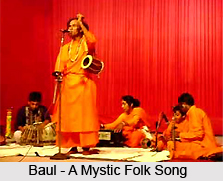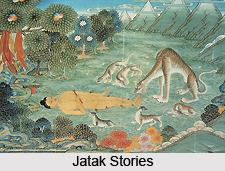 Religious influence of folk music, as already mentioned, had an immense impact on music in the eastern part of the country. As already mentioned, the form and contents of folk songs are connected with various religious cults of the entire region. In all social or political changes religious faiths conduced to the most effective part of folk-songs.
Religious influence of folk music, as already mentioned, had an immense impact on music in the eastern part of the country. As already mentioned, the form and contents of folk songs are connected with various religious cults of the entire region. In all social or political changes religious faiths conduced to the most effective part of folk-songs.
Psychological impacts of religious faiths on the people have directed songs to religious themes, whether connected or not with devotional spirit. The deities from the Puranas appear in songs at least as human beings in some way or other. Composers of folk-songs have humanized gods and goddesses. In the Indian state of Orissa - Sarala Das, a great rural poet of the medieval age rendered the Mahabharata into Oriya converting its characters into almost local human beings. Lord Shiva, in various medieval literary composition of Bengal, has been converted into a peasant. The famous Manipuri god Nangpok-ning-thou (Lord Shiva) met first Panthaibi (Parvati) appearing in the paddy fields. In both Bengali and Assamese in their medieval literature and folk-music, the episode of Manasa (the serpent goddess) has been fully humanized by poets. Thus, the impact of religious thoughts on the people of the old and medieval ages gave birth to various popular narratives.
Connected with these narratives are cults based on Saivism, Vaishnavism, Sakta-Tantrism, Sahajiya Natha cult, serpent worship or Manasa cult, Sufism mixed up with Sahajiaism and Vaishnavism with Islamic faith and so on.
 Ideas connected with agricultural festivals and episodes from the Puranas created common stories which were converted into popular cults in the form of folk narratives. The following are the instances of faiths and cults which worked continuously behind the psychological development of the common man for a long time during various periods, and thus processed the folk-music of the entire region:
Ideas connected with agricultural festivals and episodes from the Puranas created common stories which were converted into popular cults in the form of folk narratives. The following are the instances of faiths and cults which worked continuously behind the psychological development of the common man for a long time during various periods, and thus processed the folk-music of the entire region:
Buddhism: This religion played a major role in bringing out the processions of dance and music with the image of Buddha among the general public all over eastern India is a historical fact covering several centuries, say, from the fourth to the seventh century A.D.
Mangal Kavya: Some of the lyrics and songs were orally composed and sung till a certain period of history, which might have been thirteenth or fourteenth century. Gradually thereafter some genuine poets of rural areas began to contribute in writing. It existed in the rural areas making Mangal narratives part and parcel of music, and these were handled by rural poets. In some cases, episodes from these narratives were sporadically composed and sung.
Vaishnava: Influence of Vaishnava on folk music in east India has played a significant role towards improving and improvising the songs and lyrics. Some of the songs in Bengali folk music are simply based on the Vaisnava cult depicting Lord Krishna as the master, Gods beloved. Lord Krishna is a standing image of the Vaisnava faith. Since the medieval ages, various kinds of practices expressing this faith have been based on the Bhagavata Purana as interpreted through manifestations of Chaitanya.




